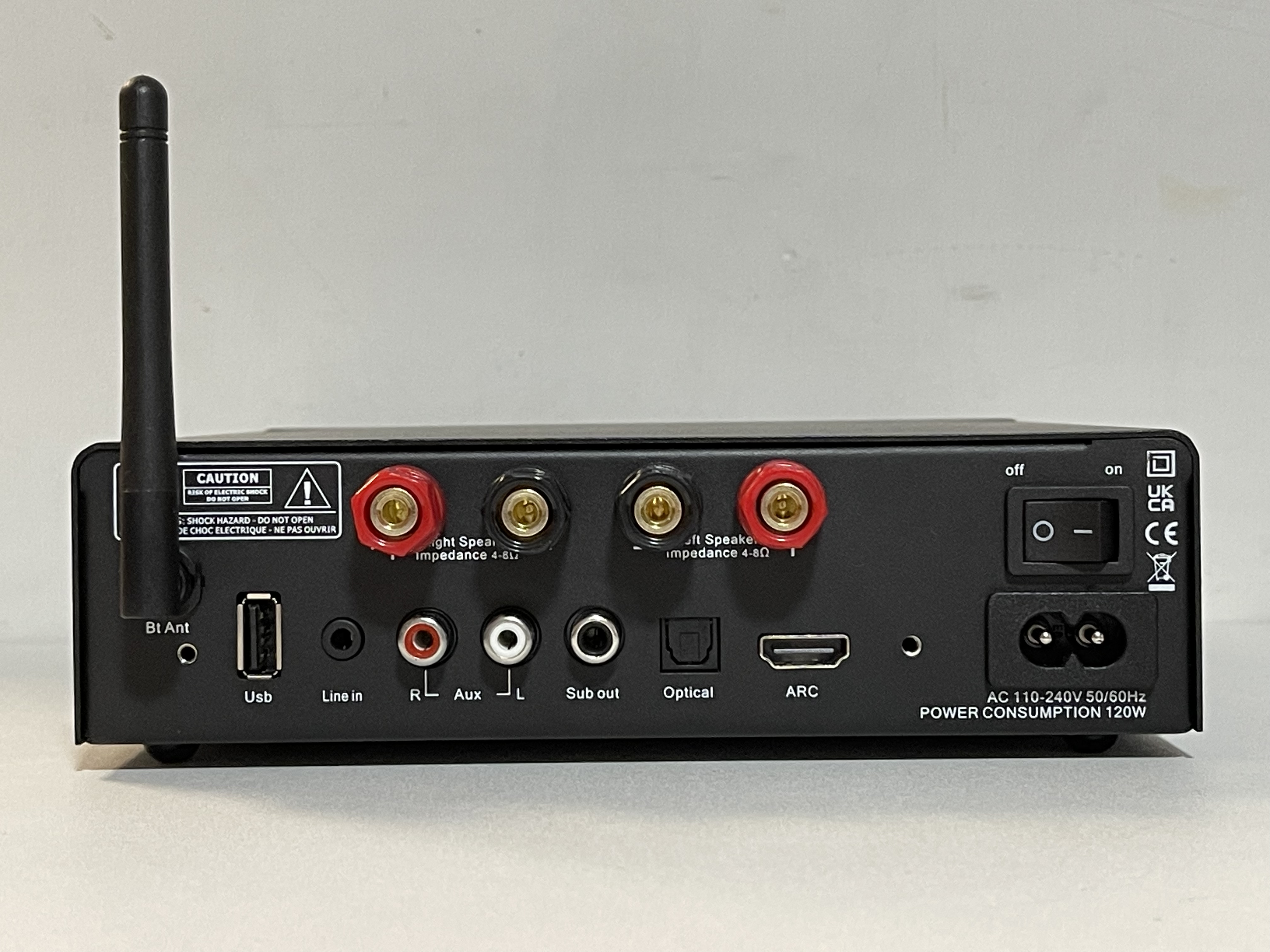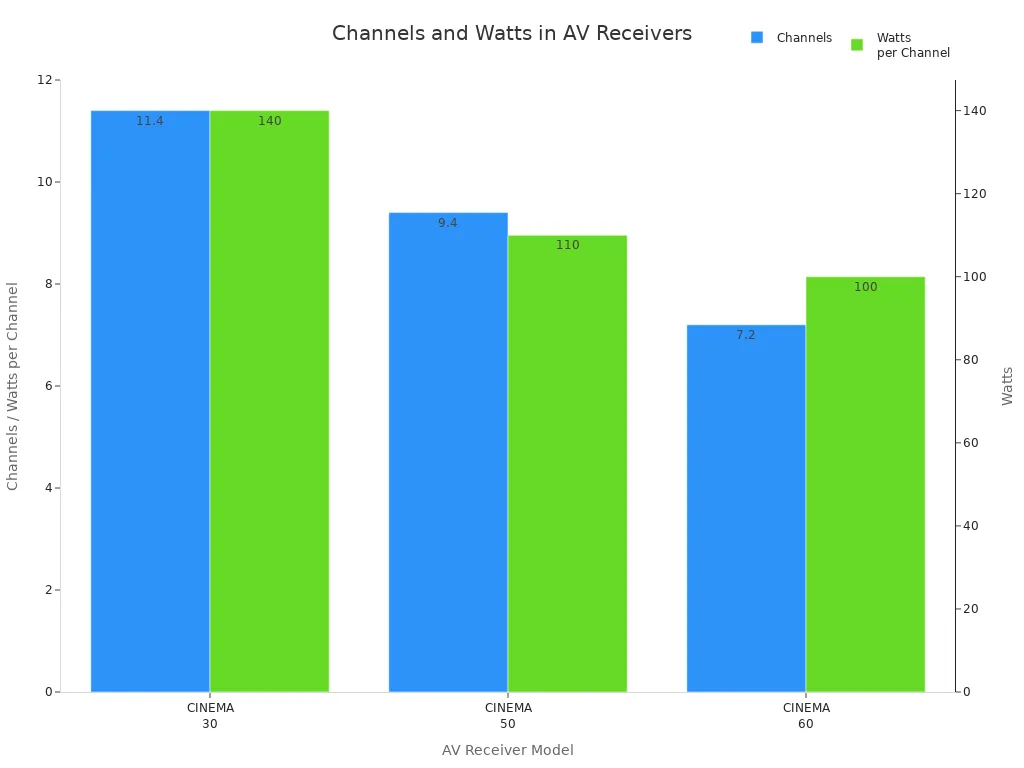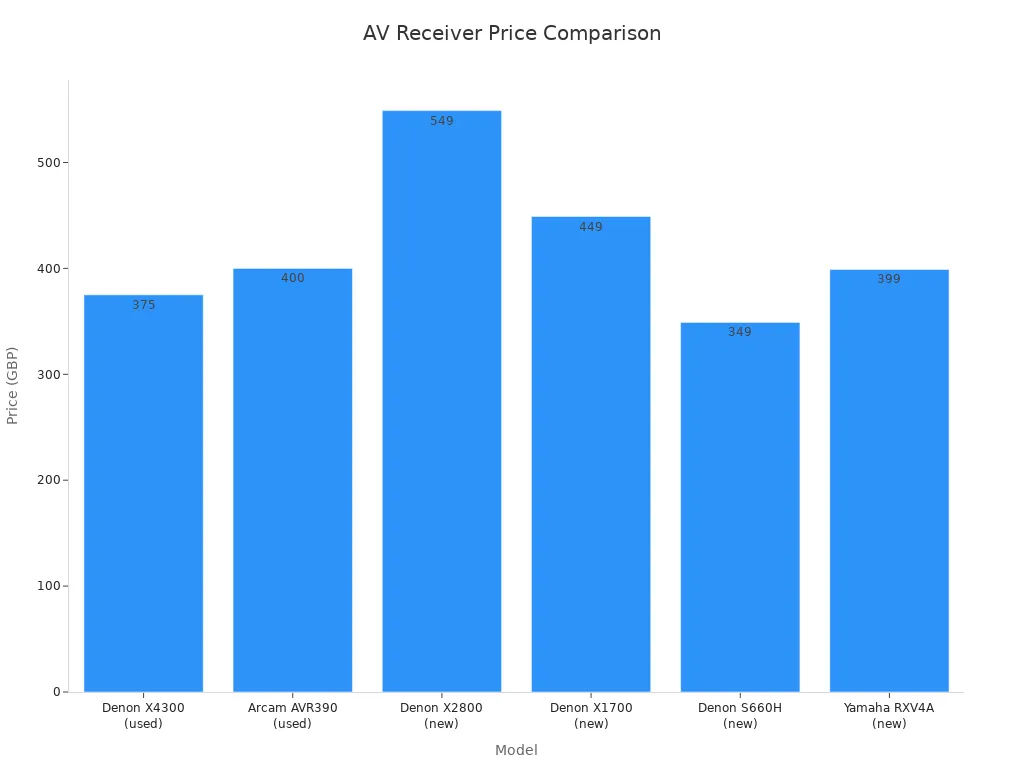T: +86 18823794757
E: sales01@davecl.com
E: sales01@davecl.com
ADD: Room 504, President Commercial Centre, 608 Nathan Road, Mongkok, Kowloon, HK
Views: 0 Author: Site Editor Publish Time: 2025-08-12 Origin: Site









You might ask what a speaker amplifier does in your home theater. It gives power to your speakers. This makes the sound louder and clearer. Most people use a receiver for this job. A receiver also handles video and other things. Some people say a home theater amplifier gives better and stronger sound. But for most home theaters, a receiver is usually enough. Think about how your receiver and speakers sound right now. Do you want more detail or stronger sound in your dream home theater? Brands like Yamaha, Sony, and Denon have choices for every setup. Before you choose, think about your room, your speakers, and how you want your home theater to grow.
A speaker amplifier makes sound signals stronger. This helps your speakers play louder and clearer. It can make your home theater sound better.
Home theater receivers work with both sound and video. Amplifiers only give power to speakers. This helps you control sound better.
Make sure your amplifier’s power matches your speakers. Also, check the impedance. This keeps your speakers safe and gives you good sound.
Pick the right number of amplifier channels for your room. Think about how big your room is. Also, consider if you want surround sound like Dolby Atmos.
Look for things like HDMI support and room calibration. Wireless options are also good. These features help your home theater last longer.
When you set up your home theater, you want your speakers to sound clear and powerful. That’s where an amplifier comes in. The amplifier takes a small audio signal from your AV receiver or another source and boosts it. This extra power lets your speakers fill the room with sound. Without an amplifier, your speakers would sound weak or quiet, even if you have a great AV receiver. The amplifier makes sure you hear every detail, from soft whispers to loud explosions.
You might wonder why you need both an amplifier and a receiver. The AV receiver handles many jobs. It connects your TV, game console, and streaming box. It also sends video to your screen and audio to your speakers. But the amplifier inside the receiver may not always give enough power for big speakers or large rooms. Sometimes, you add a separate amplifier to get better sound. This is common if you want a true home theater experience.
Tip: Always match your amplifier’s power to your speakers. Too much or too little power can damage your speakers or make your AV system sound bad.
You will find different types of amplifiers for home audio. Each type works in its own way and fits different needs. Here are the main types you might see:
Amplifier Type | How It Works | Best For | Notes |
|---|---|---|---|
Tube | Uses vacuum tubes to boost sound | Vintage lovers | Needs more care, warm sound |
Solid-State | Uses transistors for power | Most home AV setups | Reliable, clear sound |
Class A | Runs all the time for pure sound | Audiophiles | Gets hot, not very efficient |
Class AB | Mixes Class A and B for balance | Most home users | Good sound, better efficiency |
Class D | Uses digital tech for power | Portable AV, subwoofers | Very efficient, smaller size |
Most AV receivers use Class AB or Class D amplifiers. Class AB gives you a nice mix of sound quality and power. Class D is great if you want a small, cool-running AV system. If you love music and want the best sound, you might look at Class A, but it costs more and uses more energy.
Remember, your choice of amplifier changes how your speakers sound. The right amplifier can make your AV receiver and speakers work together for the best home theater experience.
You may wonder how a home theater amplifier is different from a home theater receiver. Both are important in your home theater, but they do not work the same way. Let’s look at what makes each one special.
A home theater amplifier has one main job. It makes your audio signal strong enough for your speakers. You get clear sound and can control your setup more. People who love music like amplifiers because they can change their system and get great sound.
A home theater receiver does many things. It has an amplifier inside, but also gives you more features. You can pick what you want to listen to, use radio, and get surround sound. You can connect your TV, game console, and streaming box. The receiver is the main part of your home theater. It sends audio and video where they need to go.
AV receivers have cool features like Dolby Atmos and DTS:X. They help with room correction and let you switch HDMI for 4K or 8K video. This makes your home theater ready for the future.
Amplifiers are simple. They have fewer inputs and do not handle video. If you care only about sound, a home theater amplifier is best.
Here’s a table to help you compare:
Feature | Home Theater Amplifier | Home Theater Receiver (AV Receiver) |
|---|---|---|
Main Purpose | Audio amplification | Audio + video management |
Inputs | Few | Many (HDMI, optical, analog, etc.) |
Surround Sound | Needs extra gear | Built-in (Dolby, DTS:X, Atmos) |
Video Processing | None | HDMI switching, 4K/8K support |
Customization | High | Moderate |
Size/Cost | Smaller, cost-effective | Larger, more expensive |
Tip: If you want a simple system with good sound, try a home theater amplifier. If you want one device for everything, a home theater receiver is best.
Picking between a home theater amplifier and a home theater receiver depends on what you want. Here are some examples.
Pick a home theater receiver if:
You want one device for both audio and video.
You need to switch between Blu-ray, streaming, and games easily.
You want surround sound features like Dolby Atmos and DTS:X.
You plan to use HDMI for 4K or 8K video.
You want room correction and network streaming.
A receiver makes things easy. You plug everything into one box. It does the rest. You get surround sound, video switching, and new formats. Most AV receivers work well in living rooms and family spaces.
Pick a home theater amplifier if:
You care most about sound and want to change your system.
You have speakers that need more power than a receiver gives.
You want to build your system step by step.
You do not need video or HDMI switching.
You want a cheaper way to make your audio better.
A home theater amplifier gives you control. You can choose the best gear for your speakers and room. People who love music use amplifiers for special listening rooms or custom setups.
AV receivers are great for flexibility. You can connect many devices and switch between them. You get surround sound with Dolby Atmos or DTS:X. You get HDMI for 4K video, so movies and games look and sound great. Amplifiers focus on sound, so you need other gear for video.
Note: If you want to upgrade later, start with a receiver. You can add a home theater amplifier for more power or better sound when you need it.
You do not have to pick just one. Many people use both. They start with an AV receiver for surround sound and video. Then they add a home theater amplifier for more power or better sound. This way, you get the best of both worlds.
When you pick an amplifier for your home theater, you need to think about your speakers, your room, and what you want later. This section will show you how to match power, choose the right channels, and find features that make your system special.
Getting the right power for your speakers is very important. If your amplifier is too weak, your speakers might sound boring or break if you turn it up too much. If your amplifier is too strong, you could also hurt your speakers if you play music too loud.
Here’s what you should remember:
Always match the amplifier’s power to your speaker’s RMS power rating, not the peak rating. RMS tells you how much power your speakers can handle all the time.
Brands say you should pick an amplifier with a little more power than your speaker’s RMS rating. This helps stop distortion and keeps your speakers safe.
Amplifiers with not enough power can cause distortion if you turn them up too high. This distortion can hurt your speakers more than an amplifier with a bit too much power.
It is safer to have an amplifier with a little extra power, as long as you keep the volume low.
Make sure the impedance (measured in ohms) of your amplifier matches your speakers. This helps the amplifier send power the right way.
Speaker sensitivity matters too. If your speakers are very sensitive, they need less power to get loud.
Tip: If you hear distortion or your speakers sound fuzzy, turn down the volume. This means your amplifier and speakers do not match well.
You can use this easy formula to help match power:
Amplifier Power Needed = (Speaker RMS Power x Number of Speakers) + 25% (for headroom)
For example, if you have two speakers rated at 50W RMS each: (50 x 2) + 25% = 125W total amplifier power.
The number of channels in your amplifier tells you how many speakers you can use. If you want surround sound or Dolby Atmos, you need to pay attention to this. More channels mean you can add more speakers, like height speakers for Atmos.
Here’s a quick look at how many channels you need for different Dolby Atmos and surround setups:
Configuration | Total Channels | Description |
|---|---|---|
5.1.4 Atmos | 10 | 5 main speakers, 1 subwoofer, 4 height speakers for immersive sound |
7.1.2 Atmos | 10 | 7 main speakers, 1 subwoofer, 2 height speakers |
7.1.4 Atmos | 12 | 7 main speakers, 1 subwoofer, 4 height speakers |
11.1.4 Atmos | 16 | 11 main speakers, 1 subwoofer, 4 height speakers |
If you want the full effect of Dolby Atmos, you need an amplifier or receiver with enough channels for your setup. Some receivers let you add more amplifiers later if you want to grow your system.

Room size matters when you pick an amplifier. Bigger rooms need more power and sometimes more speakers to fill the space with sound. Here’s a table to help you see how much power you might need for different room sizes and uses:
Room Size / Application Type | Recommended Amplifier Power Range (Watts) | Notes on Loudness and Music Style |
|---|---|---|
Nearfield monitoring | 25 - 250 | For close-up listening |
Home stereo | 150 - 1,500 | For average rooms with music or movies |
Coffee shop (50 seats, folk music) | 25 - 250 | Small venues |
Medium auditorium / club / house of worship (150-250 seats, folk music) | 95 - 250 | For larger gatherings |
Small outdoor festival (50 ft distance, folk music) | 250 | Outdoors need more power |
Medium auditorium / club / house of worship (150-250 seats, pop/jazz) | 250 - 750 | Louder music needs more power |
2000-seat concert hall (pop/jazz) | 400 - 1,200 | Very large spaces |
Medium auditorium / club / house of worship (150-250 seats, rock) | At least 1,500 | Rock music is very dynamic |
Small outdoor festival (50 ft distance, rock) | 1,000 - 3,000 | Outdoor rock events need lots of power |
Stadium / arena / amphitheater (100-300 ft, rock/heavy metal) | 4,000 - 15,000 | Huge venues |
If you have a normal living room, you probably need less power than a concert hall, but you still want enough to enjoy movies and music without distortion.
Note: Always plan for a little extra power and a few more channels than you think you need. This makes it easier to upgrade your system later, especially if you want to add more surround or Atmos speakers.
Modern amplifiers and receivers have lots of features that make your home theater more fun and easy to use. When you pick an amplifier, look for features that fit your life and future plans.
Here are some popular features people want today:
Support for Dolby Atmos and DTS:X for surround sound.
HDMI 2.1 inputs and outputs for 4K and 8K video, plus eARC for better audio from your TV.
Wireless audio and multi-room support, so you can play music in every room.
Voice control with Alexa or Google Assistant for hands-free use.
App-based remote control, so you can manage your system from your phone or tablet.
Room calibration and acoustic optimization, which automatically adjust sound for your space.
Sleek, compact designs that fit modern living rooms.
Gaming features like Variable Refresh Rate and Quick Media Switching for smooth gameplay.
Smart home integration, making your receiver the hub of your connected home.
Upgradability, so you can add more speakers or new tech as it comes out.
Tip: If you want to future-proof your home theater, pick an amplifier or receiver with more channels, support for the latest surround formats, and easy ways to add new features.
When you think about picking an amplifier, remember to look at your speakers, your room, and how you want your system to grow. The right amplifier and receiver combo will give you awesome sound, whether you love movies, music, or gaming. Take your time, compare features, and imagine how your home theater could sound with the perfect setup.
When you shop for the best av receiver, you want to look for features that make your home theater stand out. Start by checking the number of channels. More channels mean you can add extra speakers for surround sound or Dolby Atmos. For example, a receiver with 7.2 or 9.2 channels lets you enjoy movies with sound coming from all around you.
Next, look at watts per channel. Higher watts give your speakers more power, so your music and movies sound clear and strong. You also want to see if the receiver supports 4k and 8k video. This keeps your system ready for new TVs and streaming devices. Make sure the receiver has enough hdmi ports for your game consoles, Blu-ray players, and streaming boxes.
Check for hdr support like HDR10, Dolby Vision, and high dynamic range. These features make colors pop and pictures look real. Many av receivers now offer wireless streaming, Bluetooth, and multi-room audio. You can play music in every room with just one receiver. Look for advanced calibration tools such as Audyssey or Dirac Live. These tools adjust sound for your room, so you get the best audio possible.
Here’s a quick table comparing popular av receiver models:
Model | Channels | Watts/Channel | Surround Sound | Calibration | hdmi | hdr |
|---|---|---|---|---|---|---|
CINEMA 30 | 11.4 | 140 W | Dolby Atmos | Audyssey, Dirac | Yes | Yes |
CINEMA 50 | 9.4 | 110 W | Dolby Atmos | Audyssey, Dirac | Yes | Yes |
CINEMA 60 | 7.2 | 100 W | Dolby Atmos | Audyssey | Yes | Yes |

Tip: Always check compatibility with your speakers. Match the receiver’s power and impedance to avoid problems.
You want your av receiver to fit your budget and your future plans. Start with a solid receiver and add speakers over time. This helps you spread out costs. Set aside 10–15% of your budget for cables, brackets, and setup. Plan for future upgrades by choosing a receiver with extra hdmi ports and support for 4k and hdr formats.
Use modular racks for your av gear. This makes it easy to add new equipment later. Pick a receiver that can get firmware updates. This keeps your system working with new features. Schedule yearly check-ups for your av system to keep everything running smoothly.
Here are some common mistakes to avoid:
Skipping surround sound and relying only on soundbars.
Placing speakers inside cabinets, which muffles sound.
Choosing a screen that is too big or too small for your room.
Forgetting to budget for soundproofing.
Not hiring a professional for setup and design.
If you want to save money, consider buying a second-hand receiver. Many models offer great features at lower prices. For example, a used Denon X4300 costs less than a new model but still supports 4k and hdr. Always check the receiver buying guide before you make a choice.

Note: Think about your room size, speaker setup, and future needs. The best av receiver gives you great sound, easy upgrades, and strong compatibility.
You now understand why a receiver and amplifier are important for good sound. Look at how big your room is and what your speakers can do. Count how many channels your receiver has. See if your receiver has room calibration and a good DAC. These features help you get clear sound and surround effects. If you want better sound, try moving your speakers or fixing your room first. Do this before you buy a new receiver. When your receiver and speakers work well together, your sound will be great. Every movie night will feel special.
An amplifier gives your speakers the power they need to play music and movies loudly and clearly. You hear more detail and stronger sound when you use the right amplifier.
You usually only need a receiver for most home theaters. The receiver powers your speakers and handles video. You might add an amplifier if you want even better sound or have big speakers.
You want at least five channels for basic surround sound. If you want Dolby Atmos, look for seven or more channels. More channels let you add extra speakers for a bigger sound.
Some amplifiers work with wireless speakers. Check if your amplifier supports Bluetooth or Wi-Fi. You can play music from your phone or tablet without cables.
If your amplifier has too much power and you turn up the volume, you might damage your speakers. Always match your amplifier’s power to your speakers for safe and clear sound.
The pros and cons of active vs passive speakers.Many people like active speakers, but they may not really understand the pros and cons of passive and active speakers. They just heard that active speakers are better, which may bring a lot of trouble to their future use. It
hat exactly is "Dolby Sound"?The word "Dolby" in "Dolby Sound" is actually the surname of Dr. Dolby (formerly R.M. Dolby) in the UK. The Dolby Laboratory established by Dr. Dolby has successively invented a number of technologies such as the Dolby Noise Reduction System and the Dolby Surround Sound
Dolby Atmos speaker setup reference standardSpeakers with Dolby Atmos are designed to conduct sound upwards, creating and reproducing extremely realistic overhead sound by bouncing off the ceiling. There are two versions of speakers with Dolby Atmos:Integrated units that also include traditional for
IntroductionDesigning the perfect home theater is both an art and a science. The goal is to create an immersive cinematic experience within the comfort of your own home. Achieving this involves careful consideration of room acoustics, speaker placement, and the selection of appropriate audio-visual
Why do home theaters need power amplifiers?Why do home theaters need power amplifiers? If you want to further improve the sound quality and sound field envelopment of your theater speakers, adding a power amplifier will give you immediate results. The general entry-level power amplifier is the front
what is a pre-amplifier and what is a post-amplifierSince you want to assemble a home theater, you must first understand the functions of each device, and the power amplifier is no exception. You must know what it does and what it is used for.What is an amplifie
How to connect the rear amplifier?Power amplifiers are generally divided into front-level power amplifiers, rear-level power amplifiers and combined power amplifiers (commonly known as combined machines). A combined machine is a machine that integrates
Must-know rules for safe use of home theater audio systems1. Requirements for the use of professional home theater audio systemElectronic equipment must pay attention to the use conditions of the equipment during use, and professional home theater audio system equipment should pay more attention to
Davecl Industrial CO., LIMITED
robinwang111
+86 18823794757
+86 18665912888 (whatApp/Wechat)
sales01@davecl.com
![]() Room 504, President Commercial Centre, 608 Nathan Road, Mongkok, Kowloon, HK
Room 504, President Commercial Centre, 608 Nathan Road, Mongkok, Kowloon, HK
![]() Floor 4, Building 2, No.1, DongFeng Xilu, Qingxi Town, Dongguan, GD, China
Floor 4, Building 2, No.1, DongFeng Xilu, Qingxi Town, Dongguan, GD, China